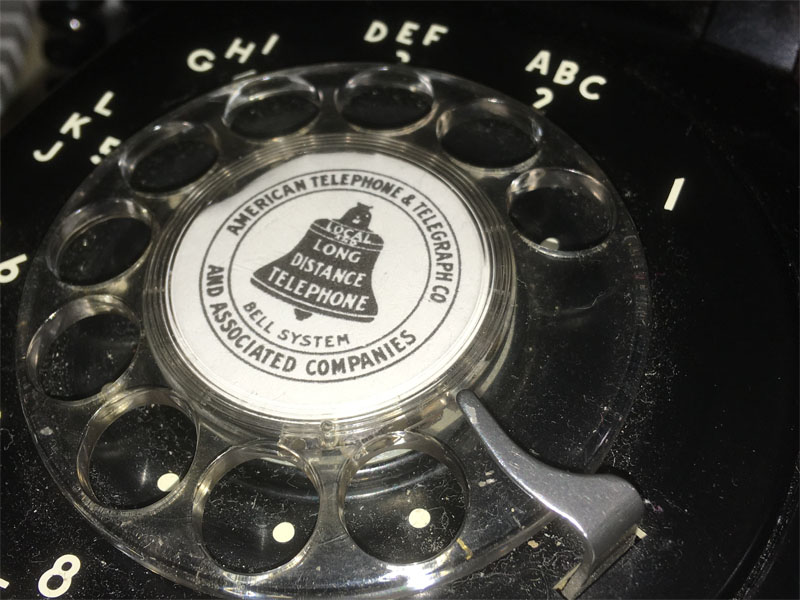Today marks a year since I began a project which has become one of the most rewarding challenges I’ve ever put upon myself; the creation of what amounts to a local telephone company 50 years ago with all the clicks, whirs, clangs, and other sounds which once populated the phone network of yesteryear.
This was by no means a solo project, though — the initial seed of it was me discovering a Voice over IP phone network known as NPSTN, which had dozens of members and thousands of numbers on it, all formatted in such a way as to mimic the way the phone network in North America used to be — from the numbering scheme of 2 letter 5 number formatting (PEnnsylvania 6-5000 anyone?) to the audio experience of Crossbar and Step switches, everything was made to sound like it did way back when, and I loved it.
This, for the most part, was all simulated — while there certainly were real switches of varying types connected, but for the most part it was all very clever code implementation on Asterisk PBX software. Play the right sound clips at the right time and that alone will give a “classic” feel to things. Take it a step further and have a centralized peer to peer VoIP network with dozens of switches all simulating things in varying ways, all run by different users, many of which also have real subscribers on them (as in, people actually using this as a real phone system) and, well, I was in a kind of paradise.
Over the later half of 2020 I had developed an intense interest in the old phone network. This coming, no joke, all because I found a typical touch-tone 2500 set at Goodwill and thought “hey, might as well give this a try.” A Magic Jack purchase later and a few internet searches later on anything to dial and I was all in.

That’s when the research came in — I began reading up on the old network and eventually listening to the Evan Doorbell phone tapes — recordings of the actual network as it was from 1970 on through into the 80’s. The sounds and the science behind all of it was like magic to me, and I just kept being drawn in more and more. That’s when I would discover NPSTN and begin calling in.
Thing is, I did this from the Magic Jack line. I eventually got equipment to allow me to use all of my rapidly-growing phone collection, be it touch tone or rotary, on the network, but still I was just calling in “from the outside.”
Then came a fateful day in February, where I noticed calls were being blocked. As it would turn out, someone with a phone number similar to mine was calling in around this same time frame and being, well, banworthy, and in trying to keep him off I got caught in the crossfire, so to speak.
A quick chat with one of the admins of NPSTN quickly got that resolved, but not before they posed the question to me of why don’t I just get an ATA (analog telephone adapter) and join in as a hosted user? Why not indeed — I liked the network, I had made contact with a human on it and he was very welcoming, maybe I should give this a go.
I don’t remember the exact thought process, but I knew I didn’t just want to be a hosted user — I wanted my own switch. I had the idea of a particular switch I wanted to simulate, and I knew a block of numbers that contained my old childhood phone number was available on the network, so I went for it. Not only did I order the ATA equipment to connect some of my phones directly to the network, but I also signed up for an account on the hosting service Digital Ocean and set up an Asterisk system on it, as per the instructions in the documents on the NPSTN website.
To say it was rough was an understatement. I was completely new to Asterisk, so everything was a learning experience. The people at NPSTN, however, were incredibly helpful and very encouraging. As Spring of 2021 rolled in I was beginning to hold my own and getting ambitious, slowly requesting more number blocks and creating other switches.
As I fleshed out my ideas more and more, I found myself enjoying the challenge and feeling an incredible level of accomplishment when I would surmount a new problem. Certainly I was asking for help left and right, but at the same time I was coming up with some ideas others had not considered, and creating new experiences which I can only say gave me a bit of a fan base in the network. I also must say I was incredibly touched when I began receiving calls from people asking to be hosted on my switch. People didn’t just like what I had created, they wanted it to be a base part of their experience on the network! Things were great.
Then came a dark phase. This is when two of the main people involved in NPSTN ended their friendship. I won’t get into it here, there’s a lot to it, I wasn’t involved, but I will say that these two no longer working together had a very rough effect on the network: their combined skills and vision really made it something special, and separated things began to stagnate and break.
I stuck with it, though. Possibly out of a feeling of obligation, I don’t know, but I wanted to help keep NPSTN alive.
Spring turned into Summer, which turned into Fall. Things, sadly, didn’t change much on NPSTN, beyond breaking worse. By this time, the other admin, the original one I had talked to back when my Magic Jack number was blocked from the network, had gone and started his own Voice over IP network, known as PhreakNet. He had invited me to it early on to help test, and I made an attempt to get a working Asterisk box on there, but the nature of things just eluded me — I felt incredibly overwhelmed and let that stay on the back burner.
Come Winter, PhreakNet had grown and I took another stab at it, and got it — my switch was on both networks. This created it’s own issues, and I had a bit of a logical crisis on how to segregate traffic on the two networks. That’s when it occurred to me this was all becoming a bit too much effort to manage, and, to be completely honest, NPSTN felt “tainted” in a way. I also had quite a bit of modernization which I needed to do to my switch, which I simply couldn’t do while still actively hosting users on NPSTN.
Come December 2021 I cut service. I let users know this was temporary, and that I intended to be back by hopefully January. That would kind of happen.
As things would go, I not only cut off hosted user service but properly changed my server setup — a new IP, tied to a proper host name, and a cleaned up dialplan configuration streamlined for PhreakNet. With a bit of trouble, things were working good, save for one problem — all the records on NPSTN still pointed to my old switch IP address, now long gone, and it was creating an issue. I had listed over 1000 numbers on NPSTN (literally half the published numbers) and the remaining admins had been made aware that none of them worked.
I would have a talk with that admin, the person who originally created NPSTN, and explain things to him, fully acknowledging that I should have said something and that was my mistake, to which I apologized and let him know what I felt. I feel the call ended on good terms, and I did have all intention of returning to NPSTN — starting fresh, in a sense, but by then things would be a bit too late: on January 28th, just a few days after my talk with the creator of NPSTN, the network shut down.
I can’t help but feel responsible for this to some degree. That’s something for another article, but Wolf River Telephone survived and is outright thriving on PhreakNet. I now have up to 130,000 lines, many hosted users, and what truly feels like an entire local Memphis area fantasy phone network, To me, it’s an art project that has been a labor of love, and hundreds of man hours. Hell, earlier today right after waking up the creator of PhreakNet and I were testing video call options through Asterisk, working around the amazingly nuanced network experience code he created. The result? We could do calls under certain conditions, but in another case we crashed his switch not once, nor twice, but thrice — yes, we killed the central switch for the entire network all in the name of science, and it was amazing.

It isn’t just the hacking. It isn’t just old phones being brought back to life. It isn’t just the clicks, whirs, clangs, and ticks. It really is the people; to know that I’m making something people much like myself are enjoying is an incredible feeling. In this incredibly over-populated digital world we live in of meme after meme, trend after trend and social media platform after social media platform, it’s nice to be able to take a step away from that, pick up the handset on an old rotary phone, dial 7 digits and, after some beautiful sounds, hear someone who I consider a friend pick up. Sure, I can do that with my cell phone, but it isn’t the same at all. It really feels like time travel to that “simpler” time we all dream about in the past, and it’s been an incredible things to be a part of. Wolf River Telephone is simply the encapsulation of that all — of me LARPing being an actual telecommunications company.
This is just one facet of the story, though. There’s a lot more to not just this, but all my phone-phreak related shenanigans over the past year plus. I hope soon to write about more of that.
Till then, catch ya next time.
